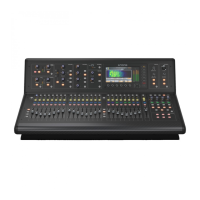94 M32 - Digital Console User Manual 95
Delay + Chorus
This combination eect merges a user-denable delay (echo) with a studio-quality chorus, sure to fatten up even the
skinniest track. Uses only one FX slot. Inspired by the TC Electronic D-Two.
The TIME rotary control adjusts the delay time, and the PATTERN rotary control sets the delay ratio for the right channel
and negative values activate a cross feedback between the two channels. The FEEDHC rotary control adjusts the delay
high-cut frequency, while FEEDBACK adjusts the number of repeats. The X-FEED control allows you to send the delay
sound to the chorus eect. The BALANCE rotary control adjusts the ratio between delay and chorus. SPEED, DELAY and
DEPTH adjust the rate, delay and modulation depth of the chorus. The right channel LFO PHASE can be oset by up to
180°, and WAVE adjusts the chorus character by shaping the LFO waveform from sine wave to triangular wave. Use the
MIX rotary control to blend the aected signal with the dry sound.
Flanger + Chamber
Add the mind-bending, lter-sweeping eect of a state-of-the-art anger to the elegant sweetening of a traditional
chamber reverb - all in one FX slot. Inspired by the Lexicon PCM 70.
The BALANCE rotary control adjusts the balance between anger and reverb. Low frequencies can be excluded with the
LO CUT rotary control, and the MIX rotary control adjusts how much of the eect is added to the signal. SPEED, DELAY
and DEPTH adjust the rate, delay and modulation depth of the anger. FEEDback can be adjusted by positive and negative
amounts. The LFO PHASE between the left and right channels can be oset by up to 180°. The PREDELAY rotary control
determines the delay before the reverb aects the signal. The DECAY rotary control adjusts how quickly the reverb fades.
SIZE controls the size of the simulated space (room, cathedral, etc.). The DAMPING rotary control determines the decay of
high frequencies within the reverb tail.
Delay + Flanger
This handy dynamic duo blends the ‘whoosh’ of soaring jet planes with classic delay, and can be adjusted from mild to
wild. This combination eect only takes up one FX slot. Inspired by the TC Electronic D-Two.
The TIME rotary control adjusts the delay time, and the PATTERN rotary control sets the delay ratio for the right channel
and negative values activate a cross feedback between the two channels. The FEEDHC rotary control adjusts the delay
high-cut frequency, while FEEDBACK adjusts the number of repeats. The X-FEED control allows you to send the delay
sound to the chorus eect. The BALANCE rotary control adjusts the ratio between delay and chorus. SPEED, DELAY and
DEPTH adjust the rate, delay and modulation depth of the chorus. The right channel LFO PHASE can be oset by up to
180°, and FEED (positive and negative amounts) adjusts the feedback eect. Use the MIX rotary control to blend the
aected signal with the dry sound.
Modulation Delay
Combining echo and chorus (and in this case, reverb too) is the domain of the Modulation Delay. By combining the two,
you can get the best of both worlds in one, dreamy-sounding eect.
The controls are separated onto twp layers; layer one for the delay, and layer two for the chorus. Use Balance to sweep
between how much of either eect is present in the output signal. Navigate to layer two by using the navigational control
buttons.
On layer one Time adjusts the time of the delay, whereas Feed controls how many echoes follow the input signal. Lo Cut
and Hi Cut are, as the names suggest, low cut and high cut lters for the aected signal. On both, Mix dictates how much
of the aected signal is sent to the output bus.
On layer two Depth controls the depth of the chorus eect, Rate controls the speed of the modulation, and Decay
controls the length of time after the initial signal where the eect is present. Damping reduces the level of the higher
frequencies in the output.
The type of reverb can be switched by pressing either of the third, fourth or fth rotary controls.
www.theaudiospecialists.eu

